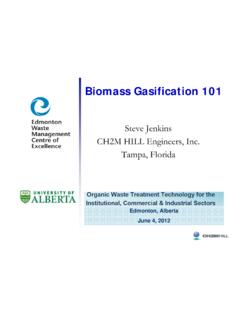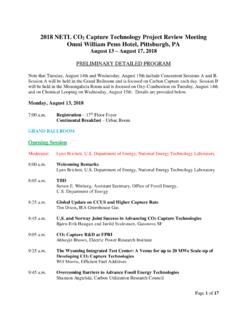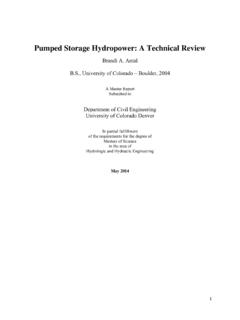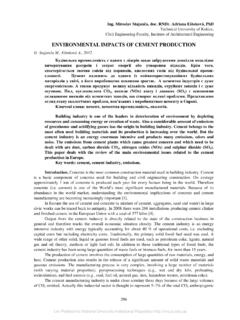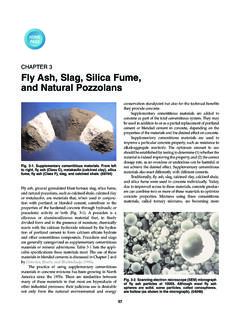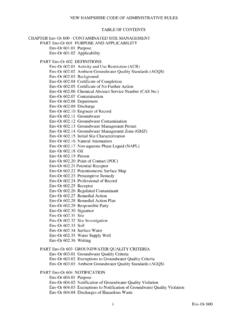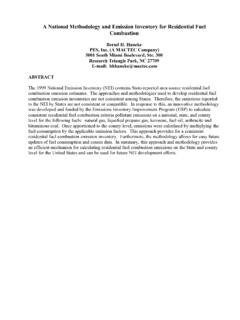Transcription of 5. POLLUTION PREVENTION AND MITIGATION MEASURES
1 5. POLLUTION PREVENTION AND MITIGATION MEASURES . POLLUTION PREVENTION , minimization, and MITIGATION MEASURES have been incorporated by Mississippi Pow- er and NACC as part of the conceptual designs of the proposed project facilities. For example, regulated air pollu- tant emissions would be reduced through the use of advanced technologies and emission controls. In addition, the IGCC power plant would be designed to capture approximately 67 percent of the CO2 that would have otherwise been emitted. Power plant facilities would be located to avoid impacts to wetlands to the extent practicable. Simi- larly, the mining plan would avoid some of the most sensitive areas, and linear facility corridors were selected giving consideration to avoiding environmentally sensitive areas. Unavoidable impacts to wetlands would require compensatory MITIGATION . Additional MEASURES would be incorporated at subsequent stages of design and engi- neering.
2 For example, exact placements of pipeline trenches and transmission line structures would be adjusted where practicable to avoid impacts to wetlands or other sensitive areas (such as cultural resources). The MITIGATION of potential adverse impacts from project activities would be achieved through implemen- tation of BMPs and compliance with requirements contained in facility permits and other applicable federal, state, or municipal regulations and ordinances. Table outlines specific POLLUTION PREVENTION and MITIGATION meas- ures, including those required under federal, state, or local regulations and permitting requirements that would be implemented for each resource area. Permits yet to be obtained by Mississippi Power and NACC would also im- pose a variety of MEASURES to prevent or minimize POLLUTION and mitigate environmental impacts through the im- position of specific permit conditions.
3 DOE may also consider additional MITIGATION as a condition of the ROD. The proposed IGCC power plant would reduce SO2, NOx, mercury, and particulate emissions by removing constituents from the syngas. The removal of nearly 100 percent of the fuel-bound nitrogen from the syngas prior to combustion in the gas turbine would result in appreciably lower NOx emissions compared to existing, conven- tional coal-fired power plants. The project is expected to remove more than 99 percent of the sulfur and more than 92 percent of the mercury. More than percent of particulate emissions would be removed using high- temperature, high-pressure filtration (rigid, barrier-type filter elements). Approximately 60 percent less CO2 would be permitted per unit of power generated compared to typical emissions rates at existing, conventional coal-fired power plants. However, there would still be some emissions of CO2, and these emissions would contribute to a net increase in global atmospheric concentrations of CO2.
4 This MITIGATION of CO2 emissions would be achieved through beneficial use for EOR and geologic storage. The design would incorporate systems to capture approximately 67 percent of the CO2, which would be delivered via pipeline for use in existing EOR operations in Mississippi. DOE has been studying the use of EOR for sequestration and believes it is a promising technology to safely store CO2 underground (DOE, 2008). Use of reclaimed municipal effluent and reuse of other water reclaimed from within the power plant and mine for cooling water makeup would greatly reduce the potential withdrawal and consumption of ground water from the Massive Sand aquifer, thereby reducing impacts on ground water resources. The proposed generation facilities would discharge no process liquid effluent from the site. Ash generated by the gasifiers would be made available for beneficial use, managed onsite, or trucked to a permitted landfill.
5 Commercial-grade anhydrous am- monia and H2SO4 would be recovered as byproducts and marketed. Avoidance and minimization of impacts on wetlands and other Waters of the United States to the extent practicable would be USACE's focus during review of CWA Section 404 permit applications submitted in the 5-1. Kemper County IGCC EIS DOE/EIS-0409D. future by Mississippi Power and NACC. If issued, USACE's permits would require impacts to wetlands to be mi- tigated to offset functional losses to Waters of the United States, including jurisdictional wetlands and streams. The required amounts and types of MITIGATION would be determined by the USACE district engineer based on practicability, degrees of impacts ( , temporary versus permanent), and the appropriate level of compensation given the aquatic resource functions that would be lost as a result of the permitted activity.
6 As stated elsewhere, the linear facility study corridor widths would allow some flexibility to avoid and minimize wetland impacts. In addition, some impacts associated with pipeline construction would be temporary, not permanent. Estimates of potential impacts to wetlands and Waters of the United States are expected to be conservative; impacts would likely be much less than the upper limits presented in Chapter 4. It would, nonetheless, be necessary to provide compensatory MITIGATION to offset losses of wetland functions relative to Waters of the United States, as described previously. Table lists the POLLUTION PREVENTION , minimization, and MITIGATION MEASURES for the proposed facili- ties. 5-2. DOE/EIS-0409D November 2009. Table POLLUTION PREVENTION and MITIGATION MEASURES Developed for the Proposed Kemper County IGCC Project Facilities Environmental Issue POLLUTION PREVENTION or MITIGATION Measure Atmospheric resources During construction, use of modern, well-maintained machinery and vehicles meeting ap- and air quality plicable emission performance standards would minimize emissions.
7 Use of dust abatement tech- niques such as wetting soils, covering storage piles, and limiting operations during windy periods on unpaved, unvegetated surfaces would reduce airborne dust and resulting impacts. The distances of most construction-related activities from the nearest property boundary and residences would mitigate most potential impacts. During operation, a number of means would be employed to prevent or reduce emissions of air pollutants, including: Application of best available control technology (BACT), as required by PSD per- mit. Partial enclosure of coal unloading, transfer and conveying equipment, plus appli- cation of water sprays, as needed, and use of baghouses. Use of high-temperature, high-pressure filters within the gasification process to col- lect more than percent of PM from the syngas. Use of sulfur removal technology to reduce sulfur concentrations in the syngas by more than 99 percent.
8 Nearly 100 percent removal of the fuel-bound nitrogen from the syngas, resulting in appreciably lower NOx emissions. Use of a reactor containing alumina-based metal sulfide to remove more than 92 percent of mercury from the syngas. High-efficiency drift eliminators would reduce water droplet emissions from the cooling towers. Monitoring to ensure compliance with emission limits would be carried out during opera- tion. It is expected that the proposed facilities would be subject to any future CAIR, applicable New Source Performance Standards, and 40 CFR 75 (Acid Rain Program). Continuous monitoring and recording of SO2, NOx, and CO emissions would be per- formed. Monitoring would be subject to stringent quality assurance/quality control (QA/QC) re- quirements to ensure that the monitored emissions data are accurate and complete. Initial and periodic compliance testing of pollutants emitted by the proposed facilities would be conducted pursuant to MDEQ requirements.
9 This stack testing, using EPA reference me- thods, would be expected to address the principal air pollutants emitted by the proposed facilities, including NOx, CO, SO2, VOCs, and PM10. An extensive network of area gas detectors would continually sample for H2S and other compounds. Detection would trigger actions to eliminate equipment leaks. Mississippi Power would design the IGCC facility to capture approximately 67 percent of CO2 that would otherwise be emitted to the atmosphere. The captured CO2 would be sent by pipeline for use in EOR. 5-3. Kemper County IGCC EIS DOE/EIS-0409D. Table POLLUTION PREVENTION and MITIGATION MEASURES Developed for the Proposed Kemper County IGCC Project Facilities (Continued, Page 2 of 5). Environmental Issue POLLUTION PREVENTION or MITIGATION Measure Geological and hydro- Fuel and chemical storage areas would be enclosed to minimize the potential to impact geological resources, soils in the event of spills.
10 In the unlikely event of a fuel spill or other release, assessment and re- including soils covery of the spill or release would be conducted in accordance with MDEQ requirements. Use of reclaimed effluent and other reclaimed water for cooling water makeup would mi- nimize the withdrawal and consumption of ground water from the Massive Sand aquifer, thereby minimizing impacts on ground water resources. Soils removed during construction would be stockpiled for reuse where possible. In the event mine dewatering operations would adversely impact local shallow ground wa- ter wells, alternative water supplies would be available. These would include the Lower Wilcox aquifer; connection to a local water supply corporation; and, possibly, tapping deeper or other sand intervals within the Middle Wilcox aquifer. Any impacts to ground water users from mining activi- ties would be mitigated as required by the SMCRA Regulations ( , Water Rights and Replace- ment, etc.)

